Too Transparent?
BUILDING-INTEGRATED PHOTOVOLTAICS
While still considered a niche market, BIPV is slowly but surely making its way into more building projects, such as Frank Gehry’s Novartis Building in Basel, Switzerland, where facade integrated photovoltaics generate energy, provide effective shading, and bring daylighting into the facility.
Previously hampered by unattractive aesthetics and high cost, newer automated semiconductor mechanical processing technologies—combined with highly durable, high-performing silicon cells—is making the technology more viable.
“The most innovative BIPV technology is now presented to the market as a complete, fully engineered, fabricated solution ready for seamless installation,” reports Solaria’s Paret. “Whether standardized or customized, the process from design to installation across the building skin is simplified, and products are being installed at costs that are comparable to traditional, non-PV systems.”
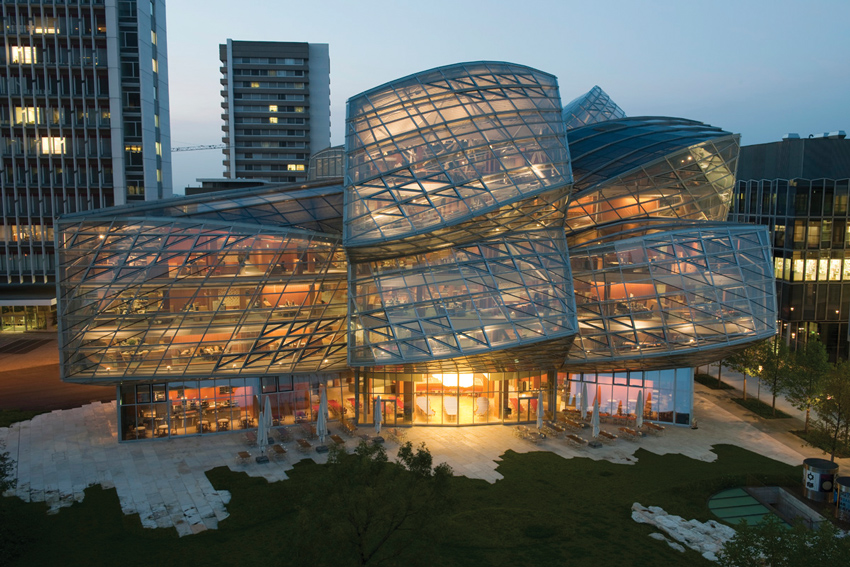
Photo courtesy of The View
Dynamic glazing was independently verified to save 30 percent in HVAC costs, more than 60 percent in lighting expenses, and post a 95 percent satisfaction rate by building occupants at the net-zero-energy Marine Corps Air Station City Hall building in Miramar, California.
In fact, the U.S. General Services Administration’s Green Proving Ground program—designed to take innovative technologies and evaluate them in real-world settings to accelerate the adoption of sustainable building technologies—recently incorporated BIPV into the program. So far, this has involved rigorous U.S. Lawrence Berkeley National Laboratory BIPV testing of energy generation, glass performance, tenant comfort, economics, and the design-build process.
The next step will be considering BIPV amongst GSA’s vast real estate portfolio, starting with a commercial pilot installation at a federal building in Kansas City, where additional data will be collected and compared with non-BIPV windows in the same building, according to Paret.
“More awareness about the real benefits of BIPV is infiltrating influencers not only in architecture, building, and construction, but also across policy makers and thought leaders. Increasingly, it is accepted that BIPV solutions offer a reliable, seamless alternative to traditional glass solutions, while providing additional value in moving glazed facades toward the goal of positive net energy gains,” he adds.
On the flip side, architects point out that for many buildings, vertical elevations with insufficient surface area are not a good fit for BIPV, which is why rooftops and exterior canopies are a more popular choice.
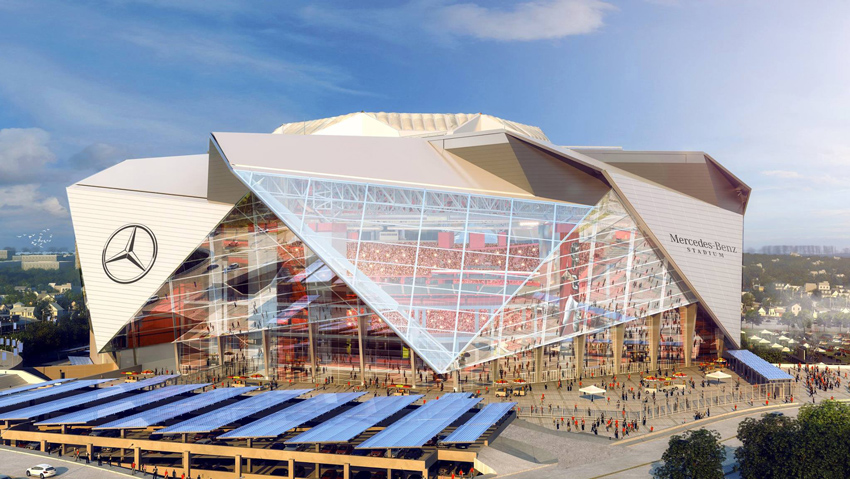
Photo courtesy of Transsolar
Frank Gehry’s Novartis Building in Basel, Switzerland, serves as a successful application of building-integrated photovoltaics.
FABRIC MEMBRANES
Another alternative to glass is architectural fabric membranes, which offer similar performance to insulated glass, with reduced structural requirements.
“Depending on the loading criteria, ethylene tetrafluoroethylene (ETFE) films have the ability to span 5- to 15-foot widths and heights over 100 feet as a single glazing unit,” explains Michael Lair, business development manager for Birdair in Dallas, Texas. “Not only does this reduce the steel required compared to glass curtain walls, but you end up with a much more unrestricted visibility, eliminating the need for horizontal extrusions required to capture the much smaller glass units. Furthermore, the large size of the ETFE glazing units also allow more light transmission.”
Case in point, ETFE film cushions were installed for the retractable roof at the Atlanta Falcon’s Mercedes-Benz Stadium, in addition to approximately 165,000 square feet of a vertical single ETFE skin supported by a cable net system around various areas of the building’s perimeter. The lightweight, transparent membrane allows daylight to flow into the space below, while providing cover.
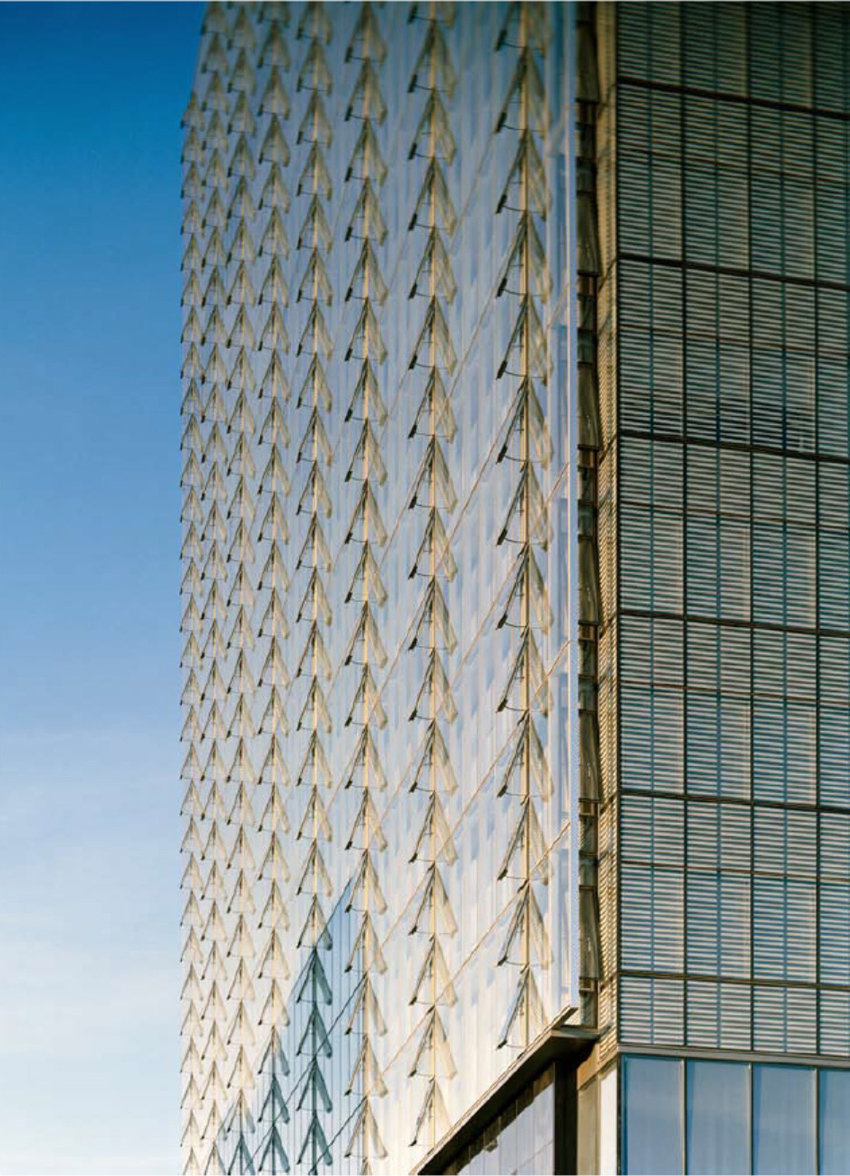
Photo courtesy of Birdair
ETFE film cushions adorn the retractable roof at the Atlanta Falcon’s Mercedes-Benz Stadium, along with a vertical single ETFE skin supported by a cable net system around various areas of the building’s perimeter.
A similar product, Teflon and PVC mesh fabrics can be an effective solar screening facade, particularly for curtain wall and ribbon window systems that aren’t meeting newer glass standards.
“The mesh provides an economical approach to helping reduce solar heat gain in old glazing systems, while giving an unattractive building facade a more modern look, without removing the existing facade,” explains Lair.
DOUBLE-SKIN FACADES
Unlike the technological solutions previously mentioned, double-skin facades are a compelling architectural solution, offering a host of energy-efficient benefits. Made from two layers of glass assemblies, an internal cavity collects solar heat, which is then used to heat the building. At the same time, the exterior and interior facades are opened at key times to bring natural ventilation into the facility.
“The constant air flow in the cavity between the two layers of exterior wall serve as a buffer to the external climate and help minimize the need for larger mechanical systems,” explains Renteria.
At the same time, double facades call for a high level of integrated engineering, require a fully coordinated building management system, are complicated assemblies, and necessitate an intense design and construction process. “The expertise and labor-intensive effort required not only to design but to fabricate, install, and then maintain these envelopes translates into higher costs than owners typically want to incur.”
“I’ve had owners that were very sustainably motivated and had the opportunity to explore double-skin facades, but unfortunately, no opportunity to actually utilize them in a final design,” says Beene. “They end up being very costly and therefore very difficult to justify when other more conventional methods of energy conservation and solar shading are more affordable.”
However, Benedict Tranel, AIA, LEED AP, a principal of Gensler, stresses the importance of factoring user comfort and natural ventilation into the investment, beyond the energy savings, as these variables have implications on the bottom line, such as supporting better occupancy rates.
For example, the double-facade designed by KPMB Architects at Winnipeg’s Manitoba Hydro Place was measured to reduce 1½ sick days per employee per year, in addition to significantly reduced service calls, on account of the extended use of natural ventilation through operable windows providing a sense of user control and connection to the outdoors.
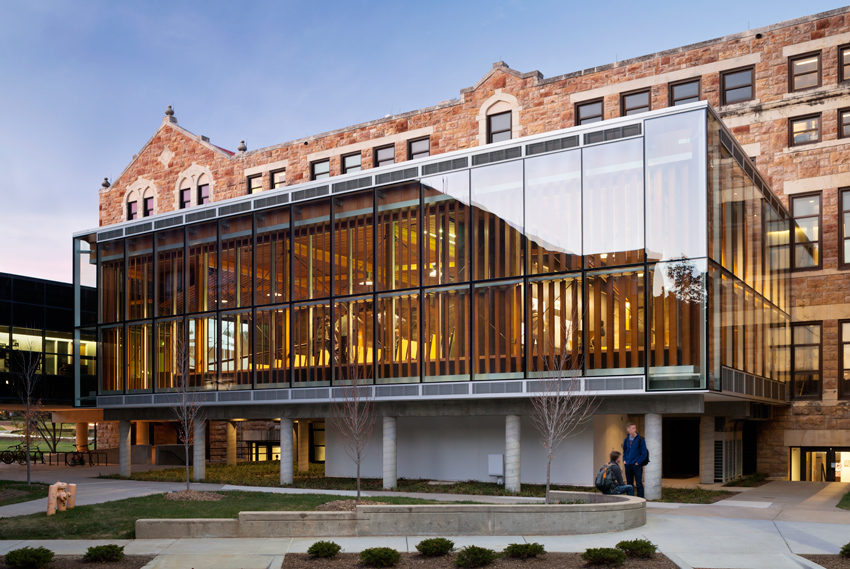
Photo courtesy of Transsolar
With a high level of user control and connection to the outdoors, thanks to a double facade designed by KPMB Architects, employee sick days at Winnipeg’s Manitoba Hydro Place were reduced by 1½ days per employee, per year.
In terms of the energy savings, post-occupancy measurements have shown that natural ventilation is being used about 40 percent of the time, which is noteworthy for Canada’s extreme climate, where average winter temperatures drops to -35 degrees Fahrenheit and summer temperatures exceed 100 degrees Fahrenheit, according to Raval.
“Similarly, the double facade of the Forum at the University of Kansas’ Marvin Hall has helped significantly reduce facade heat loss, extend the period of natural ventilation, drive natural ventilation by creating a stack effect inside the facade cavity, and provide acoustic protection,” he says.
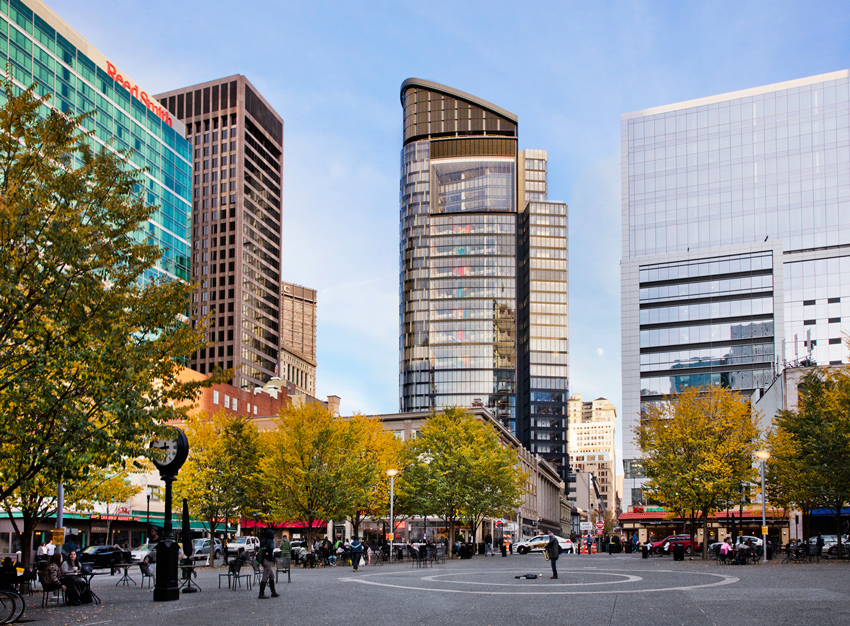
Photo courtesy of Transsolar
At University of Kansas’ Marvin Hall Forum, a double facade significantly reduces heat loss from the enclosure and promotes a high level of natural ventilation.
Patterson acknowledges that it is challenging to make economic sense of double-skin facade strategies in the current environment of what he calls lax building codes, greenwashing, and cost analysis driven by first-cost considerations. However, he anticipates that this will change at some point and performance issues will emerge as the drivers. “When this happens, double-skin strategies will be recognized as viable tools for the implementation of high-performance facade systems,” he predicts.









